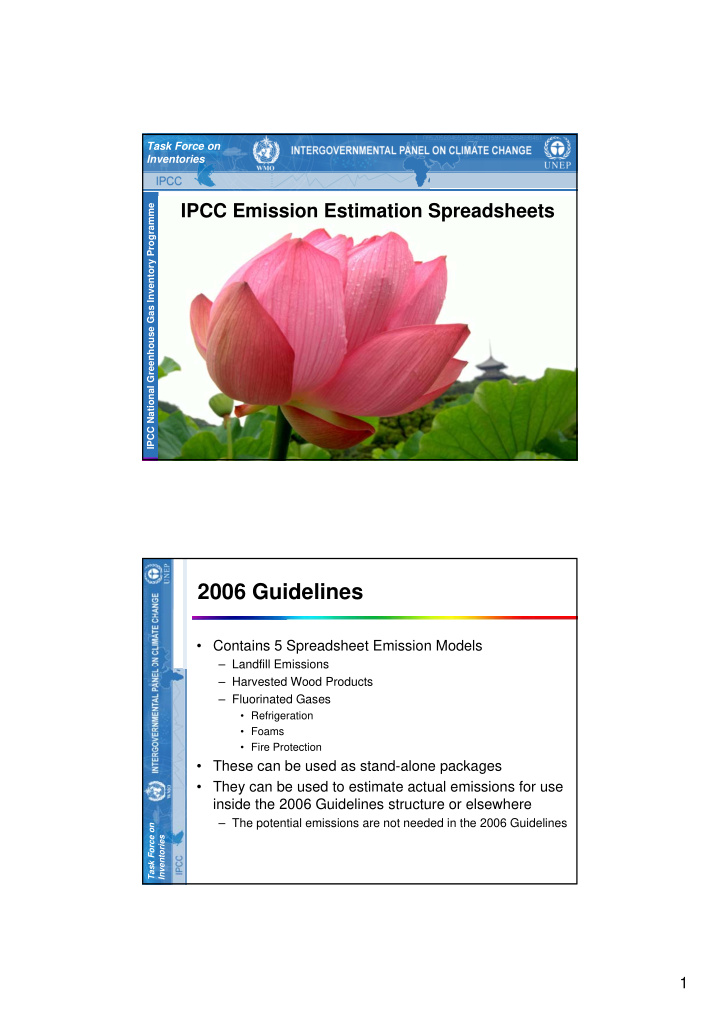



Task Force on INTERGOVERNMENTAL PANEL ON CLIMATE CHANGE Inventories IPCC National Greenhouse Gas Inventory Programme IPCC Emission Estimation Spreadsheets INTERGOVERNMENTAL PANEL ON CLIMATE CHANGE 2006 Guidelines • Contains 5 Spreadsheet Emission Models – Landfill Emissions – Harvested Wood Products – Fluorinated Gases • Refrigeration • Foams • Fire Protection • These can be used as stand-alone packages • They can be used to estimate actual emissions for use inside the 2006 Guidelines structure or elsewhere – The potential emissions are not needed in the 2006 Guidelines Task Force on Inventories 1
INTERGOVERNMENTAL PANEL ON CLIMATE CHANGE Landfills • This spreadsheet estimates emissions of methane from landfill sites as the waste decays over a number of years. • The minimum data needed is the disposals waste in the current year and national population. • Improvements can be made with waste disposals in earlier years or improved proxies for waste growth • WASTE MODEL Task Force on Inventories Task Force on INTERGOVERNMENTAL PANEL ON CLIMATE CHANGE Inventories IPCC National Greenhouse Gas Inventory Programme IPCC Harvested Wood Products Model Nalin Srivastava IPCC NGGIP TSU June 9, 2008 2
INTERGOVERNMENTAL PANEL ON CLIMATE CHANGE HWP • All wood material (including bark) that leaves forest site • Time carbon is held in products may vary depending on the products and its uses • Discarded wood products can be deposited in solid Task Force on waste disposal sites Inventories (SWDS) HWP Contribution : Alternative INTERGOVERNMENTAL PANEL ON CLIMATE CHANGE approaches • Alternative approaches to estimate and report HWP contribution to annual AFOLU CO2 emissions • Differ in how they allocate the HWP contribution between wood producing and consuming countries and what process (stock changes or atmospheric fluxes) they focus on • IPCC guidance focuses on the variables needed for using a particular approach for estimating HWP contribution and do not favour a particular approach. Task Force on Inventories 3
INTERGOVERNMENTAL PANEL ON CLIMATE CHANGE Variables Required Change in carbon Stocks in HWP from reporting country from domestic harvest and imports( PIU + PSWDS) Possible Approaches Change in carbon stock in HWP made from wood harvested in the reporting HWP country including exports Contribution (PIU + PSWDS) Annual imports of all types of wood and paper material to reporting country (PIM) Annual exports of all types of Task Force on wood and paper material from the reporting country (PEX) Inventories Annual harvest for wood products in the reporting country (H) INTERGOVERNMENTAL PANEL ON CLIMATE CHANGE HWP Spreadsheet Model • Tool to estimate the C stock in HWP and their changes to estimate the HWP contribution to AFOLU emissions using tier 1 methods • Input Data – FAO forest products production and trade data since 1961 – Data back to 1900 estimated by assuming annual rate of change from 1900-61 to be the same as rate of change of industrial round wood production – Changes in carbon held in SWDS from IPCC Waste Model Task Force on Inventories 4
INTERGOVERNMENTAL PANEL ON CLIMATE CHANGE HWP Spreadsheet Model (Cont’d.) • Other parameters required : – Half lives of solid wood and paper products – Conversion factors of sawn wood and other industrial round wood – Estimated growth rate of HWP prior to 1961 – Latest year with complete data • Assumptions: – First order decay rate of HWP pools assumed – Inflow rate to HWP assumed constant within each year – HWP C stocks in 1900 assumed zero, C(1900)=0 Task Force on Inventories INTERGOVERNMENTAL PANEL ON CLIMATE CHANGE Model Structure Atmospheric C flow from HWP HWP Pool Round wood production SWDS PIU Imports of Exports Task Force on HWP of HWP Inventories 5
Task Force on INTERGOVERNMENTAL PANEL ON CLIMATE CHANGE Inventories IPCC National Greenhouse Gas Inventory Programme Let us run the model… Task Force on INTERGOVERNMENTAL PANEL ON CLIMATE CHANGE Inventories IPCC National Greenhouse Gas Inventory Programme IPCC F-gas spreadsheet models Kiyoto Tanabe IPCC NGGIP TSU June 9, 2008 6
Tier 1 Calculation of Emissions of ODS Tier 1 Calculation of Emissions of ODS INTERGOVERNMENTAL PANEL ON CLIMATE CHANGE Substitutes Substitutes • For 3 sub-categories on ODS Substitutes under IPPU Sector, you will need to deal with the development and tracking of banks banks : – Refrigeration and Air Conditioning (2F1) Total amount of substances contained in existing equipment, – Foam Blowing Agents (2F2) chemical stockpiles, foams and other products not yet released Task Force on – Fire Protection (2F3) to the atmosphere Inventories INTERGOVERNMENTAL PANEL ON CLIMATE CHANGE “Banks Banks” ” “ Emissions Exports of Gas Imports of Gas Imports of Exports of Gas Bank of Gas in Gas in in Equipment Equipment Equipment Manufacture of Task Force on Gas Inventories 7
INTERGOVERNMENTAL PANEL ON CLIMATE CHANGE Example: Refrigeration Example: Refrigeration � This category covers – Commercial and Domestic Refrigeration – Commercial and Domestic Air Conditioning – Industrial Processes (chillers, cold storage, heat pumps etc.) – Vehicular Air Conditioning (cars, buses, trains) � Emissions occur from: Task Force on – Leakage from equipment in use Inventories – Retirement – scrapping of old equipment INTERGOVERNMENTAL PANEL ON CLIMATE CHANGE Data Required ata Required D � Emissions depend on sales in previous years – simple default approach possible � Minimum data required are: – Year of introduction of agent (F-gas) – Domestic production of agent (tonnes) in current year – Imports of agent (tonnes) in current year – Exports of agent (tonnes) in current year – Growth rate of sales of equipment that uses the agent � Production, etc in previous years will be estimated from these values. � If you have actual data for previous years, you can directly use them. � In addition you need to specify: – Emission factor for leakage from bank – default value is 15% Task Force on – Equipment lifetime – default value is 15 years Inventories • Remaining gas is released UNLESS recovery and reuse/destruction documented. (Destruction rate can be specified, if available.) 8
Recommend
More recommend